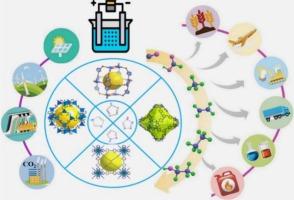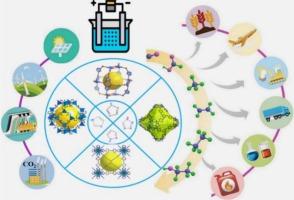电化学CO2还原反应的氮酸盐基金属有机骨架及其衍生物:最新进展与展望
IF 23.5
1区 化学
Q1 CHEMISTRY, INORGANIC & NUCLEAR
引用次数: 0
摘要
电催化二氧化碳还原反应(eCO2RR)是未来减少碳排放的潜在解决方案,但在将现有技术应用于工业应用方面仍存在挑战。因此,迫切需要设计和开发具有活性、选择性和稳定性的材料。在多孔材料中,偶氮酸盐(咪唑酸盐、四氮酸盐、三氮酸盐和吡唑酸盐)金属有机骨架(MOFs)是一类在各种应用中备受关注的mfs,特别是eCO2RR,因为它们具有不同的关键特征,即灵活的框架、丰富的活性位点、可调节的孔隙率、高稳定性和可定制的形态。尽管具有显著的特征和正在进行的研究,但尚未发表针对eCO2RR的偶氮酸mof的批判性综述。本文综述了eCO2RR的转化机理、碳产物的形成、产物的分析和鉴定策略,其次是偶氮酸mof的化学性质、框架设计原则、局部配位几何、合成注意事项以及形貌对性能的影响。随后,重点关注通过配体剪裁进行表面改性,同时深入研究结构电导率、耐久性、影响参数、电解质的作用以及设备配置对性能的影响。随后,讨论了偶氮酸盐mof及其衍生物和复合材料的最新进展,重点讨论了eCO2RR的化学组成和性能。最后,全面了解了最新的进展,潜在的挑战,建议和见解,以提高最先进的电催化剂偶氮酸mof的性能。本文章由计算机程序翻译,如有差异,请以英文原文为准。


Azolate-based metal-organic frameworks and derivatives for electrochemical CO2 reduction reactions: Recent advances and perspectives
The electrocatalytic carbon dioxide reduction reaction (eCO2RR) is a potential solution to reduce carbon emissions in the future, but there are still challenges in adopting current technology for industrial applications. Therefore, an urgent need is to design and develop active, selective, and stable materials. Among the porous materials, azolate (imidazolate, tetrazolate, triazolate, and pyrazolate) metal-organic frameworks (MOFs) are a subclass of MOFs that have attracted tremendous attention in various applications, specifically eCO2RR, due to their differentiated key characteristics, i.e., flexible frameworks, abundant active sites, adjustable porosity, high stability, and customized morphology. Despite the salient characteristics and ongoing research, no critical review has been published that covers azolate MOFs for eCO2RR. This review presents a comprehensive introduction, the conversion mechanism of eCO2RR, carbon product formation, and strategies for analyzing and identifying products, followed by the chemistry of azolate MOFs, framework design principles, local coordination geometries, synthesis considerations, and the impact of morphology on performance. Subsequently, attention is directed toward surface modification via ligand tailoring, alongside an in-depth examination of structural conductivity, durability, influencing parameters, the role of electrolytes, and the impact of device configuration on performance. Later, recent developments in azolate MOFs and their derivatives and composites are discussed, focusing on the chemical composition and performance of eCO2RR. Finally, a comprehensive understanding of the most recent advancements, underlying challenges, suggestions, and insights on improving the performance of azolate MOFs for state-of-the-art electrocatalysts has also been presented.
求助全文
通过发布文献求助,成功后即可免费获取论文全文。
去求助
来源期刊

Coordination Chemistry Reviews
化学-无机化学与核化学
CiteScore
34.30
自引率
5.30%
发文量
457
审稿时长
54 days
期刊介绍:
Coordination Chemistry Reviews offers rapid publication of review articles on current and significant topics in coordination chemistry, encompassing organometallic, supramolecular, theoretical, and bioinorganic chemistry. It also covers catalysis, materials chemistry, and metal-organic frameworks from a coordination chemistry perspective. Reviews summarize recent developments or discuss specific techniques, welcoming contributions from both established and emerging researchers.
The journal releases special issues on timely subjects, including those featuring contributions from specific regions or conferences. Occasional full-length book articles are also featured. Additionally, special volumes cover annual reviews of main group chemistry, transition metal group chemistry, and organometallic chemistry. These comprehensive reviews are vital resources for those engaged in coordination chemistry, further establishing Coordination Chemistry Reviews as a hub for insightful surveys in inorganic and physical inorganic chemistry.
 求助内容:
求助内容: 应助结果提醒方式:
应助结果提醒方式:


